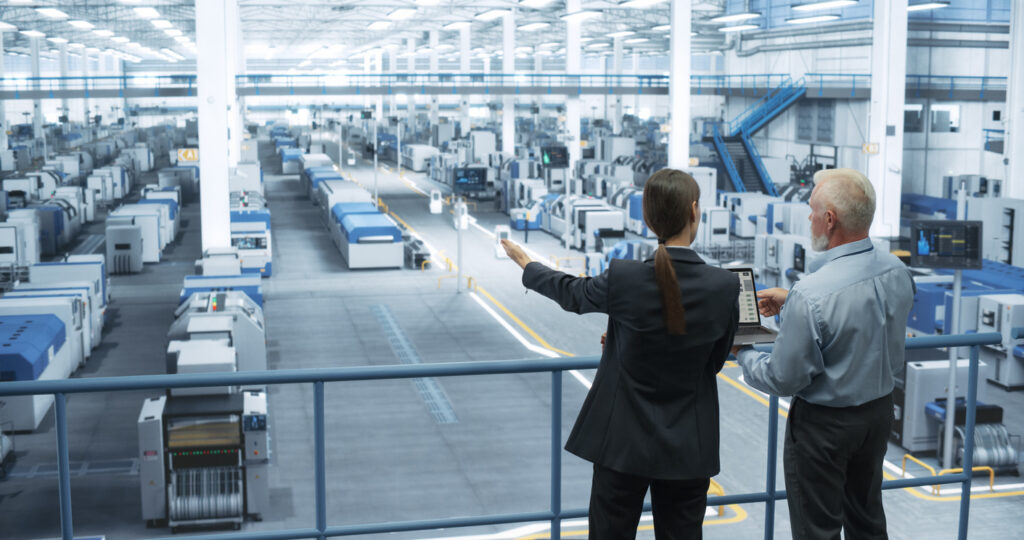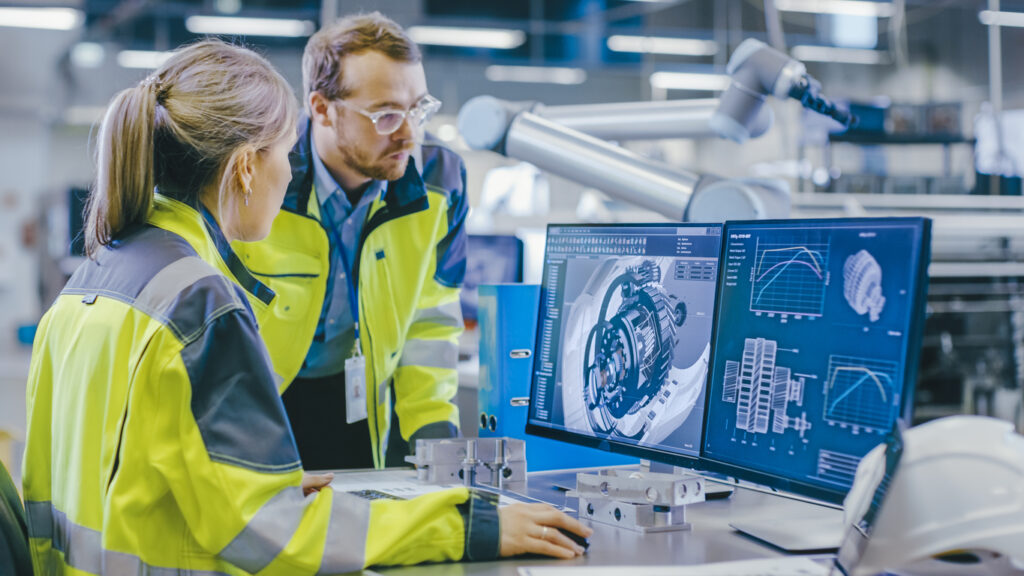Table of Contents

Digital twin technology is revolutionizing manufacturing and supply chain management by bridging the gap between the physical and digital worlds. By creating virtual replicas of physical assets, systems, and processes, digital twins enable manufacturers to better utilize high performance computing to simulate, predict, and optimize their operations in real-time. This advanced computing approach leverages technologies in the cloud such as the Internet of Things (IoT), artificial intelligence (AI), machine learning (ML), and GPU computing to enhance decision-making, improve efficiency, and drive innovation across the entire production lifecycle. From product design and development to supply chain optimization, digital twins provide powerful tools for managing complexity, reducing costs, and enhancing flexibility and responsiveness in dynamic market conditions.
What is a Digital Twin in Manufacturing?
A digital twin in manufacturing is a virtual replica of a physical asset, system, or process that is used to simulate, predict, and optimize performance across the production lifecycle. By integrating real-time data and leveraging advanced technologies such as the Internet of Things (IoT), artificial intelligence (AI), and machine learning (ML), digital twins enable manufacturers to create dynamic, data-driven models that mirror their physical counterparts. This technology, combined with the infinite storage capabilities of the cloud, allows manufacturers to improve decision-making, enhance operational efficiency, and reduce downtime through predictive maintenance and process optimization.
Historical Development and Evolution of Digital Twin Technology
The digital twin concept originated from NASA’s early efforts to create digital simulations of physical spacecraft for mission planning and remote monitoring. Over the years, the idea evolved with advancements in computational power, data analytics, and connectivity. In the manufacturing sector, digital twins emerged as a powerful tool to bridge the gap between the physical and digital worlds, allowing for more precise control and management of production processes. As IoT devices became more prevalent and data integration capabilities improved, digital twins transitioned from theoretical constructs to practical applications, becoming a cornerstone of Industry 4.0.
Key Components of a Digital Twin
Digital twins in manufacturing consist of several key components that work together to create a comprehensive and accurate virtual model of a physical asset or system:
| Key Component of a Digital Twin | Description |
| Physical Asset or System | The real-world object or process that the digital twin represents. This could be anything from a single piece of machinery, a production line, or an entire factory. The physical asset provides the foundational data needed for the digital twin to function effectively. |
| Virtual Model or Representation | A detailed digital replica of the physical asset or system. This virtual model uses advanced simulation techniques to mimic its physical counterpart’s behavior, functions, and performance. The virtual model is constantly updated with real-time data to ensure it remains accurate and relevant. |
| Data Integration and Connectivity | The seamless integration of data from various sources, including IoT sensors, enterprise systems, and external databases. This connectivity is critical for the digital twin to function correctly, as it allows for continuous monitoring and updating of the virtual model based on real-time conditions. |
Types of Digital Twins in Manufacturing
Digital twins can be categorized into different types, each serving a specific purpose in the manufacturing environment:
| Type of Digital Twin | Description |
| Product Twins | These digital twins represent individual products and are used to simulate and analyze the product’s behavior throughout its lifecycle. Product twins help manufacturers understand how products will perform under different conditions, identify potential design flaws, and optimize for performance and durability. They are particularly useful in the design and prototyping stages, allowing for virtual testing and validation before physical production begins. |
| Process Twins | Process twins focus on the manufacturing processes themselves, such as assembly lines, machining operations, or quality control procedures. These twins simulate the production process to identify inefficiencies, predict maintenance needs, and optimize workflows. Manufacturers can improve productivity, reduce waste, and enhance overall operational efficiency by analyzing process twins. |
| System Twins | System twins provide a broader perspective by representing entire systems, including multiple interconnected processes and assets. They are used to understand the interactions between different components within a manufacturing environment. System twins are valuable for optimizing factory-wide operations, managing supply chain logistics, and ensuring that all parts of the manufacturing system work harmoniously together. |
Digital Twin Applications in Manufacturing

Digital twins are being increasingly adopted across the manufacturing industry due to their ability to enhance efficiency, improve product quality, and reduce operational costs. Digital twin applications in manufacturing enable manufacturers to optimize operations, enhance product design, and ensure continuous improvement by visually representing physical assets, processes, and systems.
1. Optimizing Manufacturing Processes
A digital twin in manufacturing plays a crucial role in optimizing processes by providing real-time insights and enabling proactive management of production workflows. Some digital twin use cases in manufacturing that optimize processes include:
- Real-Time Process Monitoring and Control: Digital twins continuously monitor manufacturing processes by integrating real-time data from sensors and IoT devices. This enables operators to visualize the entire production line, identify bottlenecks, and make adjustments in real-time. Enhanced visibility helps maintain optimal performance levels, improve product quality, and reduce waste.
- Predictive Maintenance and Reduced Downtime: By analyzing data from digital twins, manufacturers can predict equipment failures before they occur. Predictive maintenance strategies use this data to schedule maintenance activities at the most convenient times, minimizing unexpected downtime and extending the lifespan of machinery. This reduces maintenance costs and improves overall equipment effectiveness (OEE).
- Simulation of Manufacturing Scenarios to Optimize Workflow: Digital twins can simulate various manufacturing scenarios to evaluate the impact of changes in workflows, such as modifying production schedules, altering machine settings, or implementing new technologies. These simulations help identify the most efficient workflows and optimize resource allocation, improving productivity and reducing operational costs.
2. Enhancing Product Design and Development
Digital twins are invaluable in product design and development, offering a digital environment for testing, validation, and iteration. Digital twin use cases in manufacturing that enhance product design and development include:
- Virtual Prototyping and Testing: Digital twins enable manufacturers to create virtual prototypes of new products and conduct extensive testing under different conditions without the need for physical prototypes. This reduces the time and cost associated with physical prototyping, allows for rapid iteration, and improves product design by identifying potential issues early in development.
- Accelerating the Design-to-Production Cycle: By providing a virtual platform for design validation and optimization, digital twins accelerate the transition from design to production. Engineers can make real-time adjustments based on digital twin simulations, reducing the time required for product development and ensuring that products meet performance and quality standards from the outset.
3. Digital Twin in Automotive and Aerospace Manufacturing
The automotive and aerospace industries have been early adopters of digital twin technology, using it to enhance product development, optimize manufacturing processes, and improve maintenance strategies.
- Automotive Manufacturing: Leading automotive manufacturers like BMW and Ford use digital twins to simulate entire production lines, optimize assembly processes, and test new vehicle designs virtually. Digital twins help identify potential issues early, reduce development costs, and speed up time-to-market. For example, BMW has implemented digital twin technology to virtually simulate factory layouts and optimize logistics processes, resulting in significant efficiency gains.
- Aerospace Manufacturing: In aerospace, companies like Boeing and Airbus leverage digital twins to model complex aircraft systems and simulate various operational scenarios. Digital twins enable the virtual testing of aircraft components under different stress conditions, enhancing safety and performance. Airbus, for instance, uses digital twins to optimize the design and manufacturing of aircraft wings, improving aerodynamic performance and reducing fuel consumption.
4. Supply Chain Optimization with Digital Twins
Digital twins are playing an increasingly pivotal role in optimizing supply chain operations. By providing a comprehensive digital representation of the entire supply chain, digital twins enable manufacturers and logistics providers to gain end-to-end visibility, enhance predictive capabilities, and improve resilience against disruptions. This technology allows organizations to streamline operations, reduce costs, and respond more effectively to dynamic market conditions.
5. End-to-End Supply Chain Visibility
A digital twin in manufacturing offers unparalleled visibility across the entire supply chain, from raw material sourcing to final product delivery.
- Tracking and Monitoring Supply Chain Components in Real-Time: Digital twins provide real-time tracking of materials, components, and products throughout the supply chain. By integrating data from IoT sensors, RFID tags, and GPS devices, digital twins allow organizations to monitor the status and location of shipments, inventory levels, and production schedules. This real-time visibility helps prevent delays, reduce lead times, and ensure supply chain activities align with production and delivery goals.
- Identifying Bottlenecks and Optimizing Logistics: Digital twins can identify bottlenecks and inefficiencies in logistics and transportation by simulating the entire supply chain. Organizations can use these insights to optimize routing, streamline warehouse operations, and improve delivery schedules. This proactive approach to logistics management reduces costs, improves service levels, and enhances overall supply chain performance.
6. Predictive Supply Chain Management
Digital twins enhance predictive capabilities in supply chain management, allowing for better forecasting and resource allocation.
- Forecasting Demand and Adjusting Production Accordingly: By integrating historical data, market trends, and real-time information, digital twins can accurately forecast demand and adjust production schedules accordingly. This capability helps manufacturers maintain optimal inventory levels, reduce excess stock, and avoid production overages or shortages, ensuring a more balanced and efficient production process.
- Reducing Inventory Costs and Enhancing Just-In-Time Manufacturing: Digital twins enable more precise inventory management by predicting inventory needs based on demand forecasts and real-time supply chain data. This enhances Just-In-Time (JIT) manufacturing practices by ensuring that materials and components arrive precisely when needed, reducing storage costs and minimizing waste. The result is a leaner, more cost-effective supply chain that can respond quickly to changing customer demands.
7. Resilience and Risk Management
Digital twins are vital in enhancing supply chain resilience and managing risks associated with disruptions.
- Scenario Planning for Supply Chain Disruptions: Digital twins allow organizations to simulate various disruption scenarios, such as natural disasters, supplier failures, or transportation delays. By analyzing these scenarios, companies can develop contingency plans and optimize their response strategies, minimizing the impact of disruptions on operations and maintaining business continuity.
- Enhancing Supply Chain Flexibility and Responsiveness: Digital twins enable organizations to quickly adapt to changing conditions and make informed decisions by providing a dynamic, real-time view of the supply chain. This flexibility enhances the supply chain’s responsiveness, allowing companies to shift production, reroute shipments, or adjust sourcing strategies as needed to mitigate risks and capitalize on emerging opportunities.
Supply Chain Optimization with Digital Twins
A digital twin in manufacturing is capable of transforming supply chain management by providing a comprehensive digital representation of the entire supply chain, enabling companies to gain deeper insights, enhance predictive capabilities, and improve overall resilience. By leveraging digital twin technology, organizations can achieve real-time visibility, optimize logistics, and proactively manage risks, leading to more efficient and responsive supply chain operations.
End-to-End Supply Chain Visibility
Digital twins offer a powerful tool for achieving complete visibility across the entire supply chain, from sourcing to delivery.
- Tracking and Monitoring Supply Chain Components in Real-Time: Digital twins enable real-time tracking and monitoring of all supply chain components, including raw materials, work-in-progress inventory, and finished goods. By integrating data from IoT sensors, GPS, and RFID technologies, digital twin technology in manufacturing provides continuous updates on each component’s location, condition, and status. This level of visibility helps prevent delays, improve coordination, and ensure timely deliveries.
- Identifying Bottlenecks and Optimizing Logistics: By simulating the entire supply chain network, digital twins help identify bottlenecks and inefficiencies in logistics processes, such as transportation delays or warehouse congestion. Organizations can use these insights to optimize routing, streamline warehouse operations, and improve inventory management. This proactive approach reduces operational costs, enhances delivery performance, and ensures a smooth flow of goods through the supply chain.
Predictive Supply Chain Management
the use of digital twin for predictive maintenance in manufacturing includes predictive enabling more accurate demand forecasting and inventory management.
- Forecasting Demand and Adjusting Production Accordingly: By analyzing historical sales data, market trends, and real-time demand signals, digital twins can forecast future demand with greater accuracy. This allows companies to adjust production schedules dynamically, ensuring that they produce the right amount of product at the right time. This demand-driven approach reduces waste, minimizes stockouts, and aligns production with market needs.
- Reducing Inventory Costs and Enhancing Just-In-Time Manufacturing: Digital twins support Just-In-Time (JIT) manufacturing by providing precise insights into inventory levels and supply chain dynamics. By predicting inventory needs and aligning them with production schedules, digital twins help reduce excess inventory, lower storage costs and minimize the risk of obsolescence. This leaner approach to inventory management improves cash flow and enhances overall supply chain efficiency.
Resilience and Risk Management
A digital twin in manufacturing works to enhance supply chain resilience and helps to manage risks associated with unexpected disruptions.
- Scenario Planning for Supply Chain Disruptions: Digital twins allow companies to simulate various disruption scenarios, such as natural disasters, supplier failures, or geopolitical events. By modeling the impact of these disruptions on supply chain operations, companies can develop contingency plans, identify alternative suppliers or routes, and ensure business continuity. This capability helps minimize the impact of disruptions and maintain customer satisfaction.
- Enhancing Supply Chain Flexibility and Responsiveness: Digital twins provide a real-time, dynamic view of the supply chain, allowing organizations to quickly adapt to changes in demand, supply, or market conditions. This enhanced flexibility enables companies to make informed decisions, such as reallocating resources, adjusting production plans, or rerouting shipments. By increasing responsiveness, digital twins help companies remain competitive in a rapidly changing market environment.
Better Manufacturing Processes with Digital Twins
Digital twins are revolutionizing manufacturing processes by enabling greater automation, improving quality control, and fostering effective human-machine collaboration. Digital twins empower manufacturers to streamline operations, reduce waste, enhance quality, and improve worker safety and productivity by providing a real-time, data-driven virtual representation of physical assets and systems.
1. Process Automation and Optimization
Digital twins are essential for automating and optimizing manufacturing processes, leading to more efficient production lines and better resource management.
- Streamlining Production Lines with Automated Feedback: Digital twins provide real-time insights into the performance of production lines, enabling automated feedback loops that adjust operations based on live data. For example, if a sensor detects a deviation in a machine’s operation, the digital twin can trigger automated adjustments to correct the issue without manual intervention. This capability helps maintain optimal performance, reduces downtime, and increases throughput.
- Reducing Waste and Improving Resource Utilization: By simulating different production scenarios and analyzing data on material usage, digital twins help identify areas where waste can be minimized and resources can be better utilized. This lowers production costs and supports sustainable manufacturing practices by reducing material waste and energy consumption.
2. Quality Control and Assurance
Digital twins enhance quality control processes by providing real-time monitoring and predictive analytics, ensuring that products consistently meet high standards.
- Real-Time Quality Monitoring and Defect Detection: Digital twins integrate data from various sensors and inspection systems to monitor product quality in real time. This continuous monitoring allows for immediate detection of defects or deviations from quality standards, enabling quick corrective actions. As a result, manufacturers can reduce scrap rates, avoid costly recalls, and maintain high levels of customer satisfaction.
- Implementing Zero-Defect Manufacturing with Digital Twins: Zero-defect manufacturing aims to eliminate all defects from production processes. Digital twins facilitate this by providing detailed insights into the causes of defects and enabling predictive maintenance strategies to prevent issues before they occur. Digital twins help manufacturers achieve near-perfect quality and improve overall process reliability by simulating production scenarios and analyzing historical defect data.
3. Human-Machine Collaboration
Digital twins play a crucial role in enhancing human-machine collaboration and improving worker productivity, safety, and training.
- Enhancing Worker Productivity and Safety Through Digital Twin Insights: Digital twins provide workers with real-time information on machine status, operational conditions, and safety hazards, enabling them to make informed decisions and take proactive measures. This improves productivity by reducing errors and enhancing workflow efficiency. Additionally, digital twins can help identify potential safety risks, such as equipment malfunctions or hazardous conditions, allowing for timely interventions to protect workers.
- Training and Simulation for Skill Development and Process Understanding: Digital twins offer a powerful training and skill development platform by simulating real-world scenarios in a virtual environment. Workers can use digital twins to gain hands-on experience with new machinery, processes, or workflows without the risks associated with live production. This simulation-based training enhances process understanding, accelerates learning curves, and improves overall operational readiness.
GPU Computing and Digital Twins

GPU computing is becoming increasingly important in developing and deploying a digital twin in manufacturing, particularly in industries where complex simulations, real-time rendering, and high-performance data processing are essential. By harnessing the parallel processing power of GPUs, digital twins can achieve faster, more accurate simulations and visualizations, driving innovation and efficiency in manufacturing and other sectors.
Role of GPU Computing in Digital Twin Simulations
GPUs are particularly well-suited for handling the computational demands of digital twin simulations due to their ability to perform parallel processing. This makes them ideal for tasks that require large-scale data processing and real-time updates.
- Accelerating Complex Simulations and Data Processing: Digital twins often involve complex simulations that model physical phenomena in detail, such as fluid dynamics, structural analysis, or thermal performance. With their massive parallel processing capabilities, GPUs can handle multiple computations simultaneously, significantly accelerating these simulations. This speed-up enables more frequent updates to the digital twin, providing a more accurate and timely reflection of the physical asset or process.
- Real-Time Rendering and Visualization of Digital Twins: Real-time rendering and visualization are critical for digital twins, especially in applications where immediate feedback and interactive environments are required. GPUs excel at rendering high-resolution graphics quickly, enabling real-time visualization of digital twins. This capability allows engineers and decision-makers to interact with the digital model, analyze different scenarios, and make data-driven decisions without delay.
High-Performance Computing Integration
Integrating GPUs with HPC platforms further enhances the capabilities of digital twins, particularly for large-scale implementations that require substantial computational resources.
- Leveraging GPUs for Scalable Digital Twin Implementations: In HPC environments, GPUs are used to scale digital twin simulations across multiple nodes, allowing for the handling of massive datasets and highly complex models. This scalability is crucial for aerospace, automotive, and energy industries, where digital twins must simulate entire systems or processes with high fidelity. Leveraging GPUs within HPC frameworks ensures that digital twin models are faster, more accurate, and capable of simulating complex interactions.
- Cloud-Based GPU Solutions for Large-Scale Manufacturing Operations: Cloud-based GPU solutions provide a flexible and scalable platform for deploying digital twins in large-scale manufacturing operations. Cloud providers like AWS, Microsoft Azure, and Google Cloud offer GPU-accelerated instances that allow companies to run digital twin simulations on-demand without the need for significant capital investment in hardware. This model is particularly advantageous for manufacturers requiring high computational power for specific projects but not wanting to maintain a dedicated on-premises HPC infrastructure.
While a vital tool, HPC deployments can come with challenges. Learn how to overcome them.Uncover the latest trends in AI cloud computing and how to leverage the power of AI.

Conclusion
Digital twins are rapidly becoming a cornerstone of modern manufacturing and supply chain management, offering unprecedented optimization, innovation, and risk management opportunities. By leveraging advanced computing technologies like AI, ML, IoT, and GPU-powered simulations, a digital twin in manufacturing enables real-time insights, predictive maintenance, and enhanced human-machine collaboration. As industries continue to embrace digital transformation, the integration of digital twin technology will be crucial for achieving sustainable growth, improving operational efficiency, and maintaining a competitive edge in an increasingly interconnected global market.
Create your customized cloud environment to support digital twins with NZO Cloud. Reach out to us today for a free trial.


